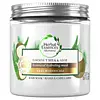What's inside
What's inside
 Key Ingredients
Key Ingredients

No key ingredients
 Benefits
Benefits

 Concerns
Concerns

 Ingredients Side-by-side
Ingredients Side-by-side

Water
Skin ConditioningStearyl Alcohol
EmollientSilicone Quaternium-26
EmollientBehentrimonium Chloride
PreservativeCetyl Alcohol
EmollientCocos Nucifera Fruit Juice
EmollientHistidine
HumectantAloe Barbadensis Leaf Juice
Skin ConditioningEcklonia Radiata Extract
Skin ConditioningParfum
MaskingBenzyl Alcohol
PerfumingDisodium EDTA
Citric Acid
BufferingSodium Hydroxide
BufferingMethylchloroisothiazolinone
PreservativeMethylisothiazolinone
PreservativeWater, Stearyl Alcohol, Silicone Quaternium-26, Behentrimonium Chloride, Cetyl Alcohol, Cocos Nucifera Fruit Juice, Histidine, Aloe Barbadensis Leaf Juice, Ecklonia Radiata Extract, Parfum, Benzyl Alcohol, Disodium EDTA, Citric Acid, Sodium Hydroxide, Methylchloroisothiazolinone, Methylisothiazolinone
Water
Skin ConditioningGlycerin
HumectantDimethicone
EmollientIsopentyldiol
HumectantHydrogenated Raspberry Seed Oil
EmollientBehentrimonium Chloride
PreservativeStearyl Alcohol
EmollientSorbitol
HumectantAminopropyl Dimethicone
Hydroxyethyl Urea
HumectantHydroxyethyl Hydroxypropyl C12-15 Alkoxypropylamine Oxide
CleansingSteartrimonium Chloride
PreservativeLactic Acid
BufferingCamellia Seed Oil
Phytosteryl/Octyldodecyl Lauroyl Glutamate
Skin ConditioningDimethyl Glutamic Acid
Skin ConditioningRoyal Jelly Extract
Skin ConditioningSodium Hyaluronate
HumectantHydrolyzed Conchiolin Protein
Skin ConditioningIsopropyl Alcohol
SolventOctyldodecanol
EmollientAlcohol Denat.
AntimicrobialCitric Acid
BufferingAmmonium Lactate
BufferingButylene Glycol
HumectantDipropylene Glycol
HumectantAdenosine Phosphate
Skin ConditioningAmodimethicone
PPG-2-Deceth-12
EmulsifyingTocopherol
AntioxidantPhenoxyethanol
PreservativeBenzyl Benzoate
AntimicrobialParfum
MaskingCI 17200
Cosmetic ColorantCI 15985
Cosmetic ColorantWater, Glycerin, Dimethicone, Isopentyldiol, Hydrogenated Raspberry Seed Oil, Behentrimonium Chloride, Stearyl Alcohol, Sorbitol, Aminopropyl Dimethicone, Hydroxyethyl Urea, Hydroxyethyl Hydroxypropyl C12-15 Alkoxypropylamine Oxide, Steartrimonium Chloride, Lactic Acid, Camellia Seed Oil, Phytosteryl/Octyldodecyl Lauroyl Glutamate, Dimethyl Glutamic Acid, Royal Jelly Extract, Sodium Hyaluronate, Hydrolyzed Conchiolin Protein, Isopropyl Alcohol, Octyldodecanol, Alcohol Denat., Citric Acid, Ammonium Lactate, Butylene Glycol, Dipropylene Glycol, Adenosine Phosphate, Amodimethicone, PPG-2-Deceth-12, Tocopherol, Phenoxyethanol, Benzyl Benzoate, Parfum, CI 17200, CI 15985
 Reviews
Reviews

Ingredients Explained
These ingredients are found in both products.
Ingredients higher up in an ingredient list are typically present in a larger amount.
This ingredient is a preservative and often used for it's anti-static properties. You'll most likely see this ingredient in hair conditioners.
It does not cause irritation or sensitization in leave-on products at 1-5%.
Citric Acid is an alpha hydroxy acid (AHA) naturally found in citrus fruits like oranges, lemons, and limes.
Like other AHAs, citric acid can exfoliate skin by breaking down the bonds that hold dead skin cells together. This helps reveal smoother and brighter skin underneath.
However, this exfoliating effect only happens at high concentrations (20%) which can be hard to find in cosmetic products.
Due to this, citric acid is usually included in small amounts as a pH adjuster. This helps keep products slightly more acidic and compatible with skin's natural pH.
In skincare formulas, citric acid can:
While it can provide some skin benefits, research shows lactic acid and glycolic acid are generally more effective and less irritating exfoliants.
Most citric acid used in skincare today is made by fermenting sugars (usually from molasses). This synthetic version is identical to the natural citrus form but easier to stabilize and use in formulations.
Read more about some other popular AHA's here:
Learn more about Citric AcidParfum is a catch-all term for an ingredient or more that is used to give a scent to products.
Also called "fragrance", this ingredient can be a blend of hundreds of chemicals or plant oils. This means every product with "fragrance" or "parfum" in the ingredients list is a different mixture.
For instance, Habanolide is a proprietary trade name for a specific aroma chemical. When used as a fragrance ingredient in cosmetics, most aroma chemicals fall under the broad labeling category of “FRAGRANCE” or “PARFUM” according to EU and US regulations.
The term 'parfum' or 'fragrance' is not regulated in many countries. In many cases, it is up to the brand to define this term.
For instance, many brands choose to label themselves as "fragrance-free" because they are not using synthetic fragrances. However, their products may still contain ingredients such as essential oils that are considered a fragrance by INCI standards.
One example is Calendula flower extract. Calendula is an essential oil that still imparts a scent or 'fragrance'.
Depending on the blend, the ingredients in the mixture can cause allergies and sensitivities on the skin. Some ingredients that are known EU allergens include linalool and citronellol.
Parfum can also be used to mask or cover an unpleasant scent.
The bottom line is: not all fragrances/parfum/ingredients are created equally. If you are worried about fragrances, we recommend taking a closer look at an ingredient. And of course, we always recommend speaking with a professional.
Learn more about ParfumStearyl Alcohol is a type of fatty alcohol from stearic acid. It is a white, waxy compound used to emulsify ingredients.
Fatty Alcohols are most often used as an emollient or to thicken a product. Emollients help soothe and hydrate the skin by trapping moisture.
They are usually derived from natural fats and oils and therefore do not have the same drying or irritating effect as solvent alcohols. FDA allows products labeled "alcohol-free" to have fatty alcohols.
Learn more about Stearyl AlcoholWater. It's the most common cosmetic ingredient of all. You'll usually see it at the top of ingredient lists, meaning that it makes up the largest part of the product.
So why is it so popular? Water most often acts as a solvent - this means that it helps dissolve other ingredients into the formulation.
You'll also recognize water as that liquid we all need to stay alive. If you see this, drink a glass of water. Stay hydrated!
Learn more about Water